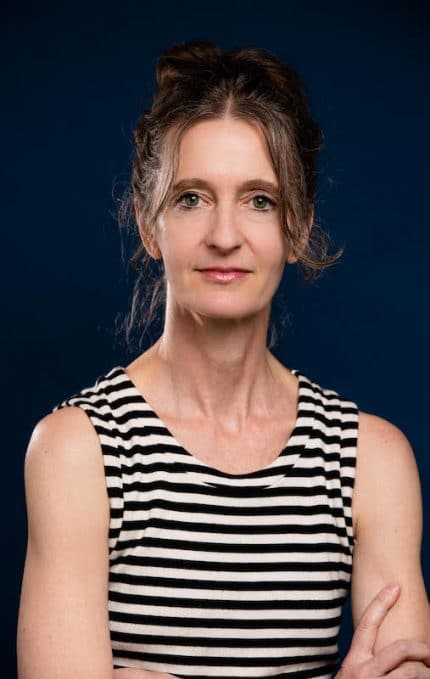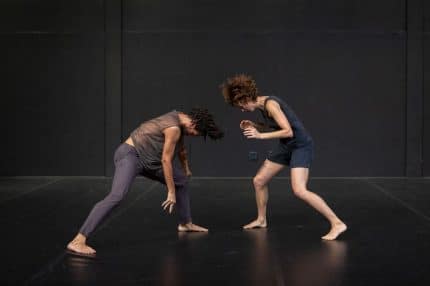Kimberley Bartosik on choreographing and her upcoming works

Kimberly Bartosik has been a prolific choreographer and artistic developer for over 20 years.
Her organisation daela facilitates the development of artistic work, and is under fiscal sponsorship of New York Live Arts. Her work has been commissioned and presented worldwide in various festivals including American Dance Festival (2017), The Chocolate Factory Theater (2017), and Chorégraphique Internationales de Seine-Saint Denis (France). She is responsible for two new works which will be performed at Arts Centre Melbourne’s upcoming Supersense Festival of the Ecstatic, which celebrates modern, traditional, evolving and emerging forms of ecstatic ritual and transformational expression.
I hunger for you explores ideas of faith, violence, compassion and life force, transposing these ideas into a primal and rhythmic dance performance. Choreographed by Kimberley, 6 dancers will explore her personal experiences on stage.
The Cunningham Solos will be presented as part of MINIMAL, 4 hour long theatrical experience unfolding throughout the buildings of Arts Centre Melbourne. Dancers Christian Allen, Aaron Burr Johnson and Lindsey Jones will perform these solos, choreographed by Kimberley and fellow former Cunningham dancer Dylan Crossman, to celebrate the centenary of the legendary choreographer’s life and career.
I had a chat with Kimberley about both pieces ahead of their performances at Arts Centre Melbourne this month.
Could you tell me a bit about your history with dance?
It’s pretty unusual. I started dancing at age 15 and by 21 was a member of the Merce Cunningham Dance Company! If I had started early, I might have quit before becoming professional. I had a really “normal” childhood and if I’d been inside a dance studio for those years, with the kind of extreme pressure young dancers experience, I might not have stayed with it. I’ve also tried quitting many times–refocusing my career to other things–but I keep coming back
What do you think it is about dance that has made it such a long lasting and well-loved art form?
Ha! I think I would need to work on a full essay to appropriately and articulately answer this complex question! But I might refer to the ephemeral nature of dance as something that makes us keep wanting to come back. It’s immateriality and impermanence leaves a specific, profound mark on us that makes us hungry for more.

What inspired you to choreograph?
I resisted becoming a choreographer for a long time after leaving the Merce Cunningham company. I wasn’t sure what my voice could possibly add to what Merce had already put out there? I actually left dance in 2000 and enrolled in graduate school, earning an MA in Art Criticism and 20th Century Visual Art History. I was hungry to understand the connection between artists, critics, and the particular moment in history during which an artist produced work. My studies plunged me into dense texts on critical theory and cultural criticism, with a particular focus on Post-Structuralist French Feminist Theory. However, two-thirds of the way through my graduate program, I knew that, while my mind had been radically opened, I was not a scholar. Right before graduating, I accepted my first invitation to choreograph. Culling from the feminist texts on language and body I had consumed, this first project was seeded from a question that would define my early choreographic works: what is inside my female body that the powerful male artists I spent my 20s with haven’t gotten to yet?
Can you tell me a bit about I hunger for you and the Cunningham Solos? What can an audience expect from both?
They present radically different versions of our art form, yet have deep threads that connect them–mostly to do with rigor, difficulty, power and danger. My work is all about riding an edge, and Merce loved to ask that dancers take his more formal vocabulary to the most extreme physical place. These edges are different, but both can inspire emotional responses. I also think both have quite a bit of beauty.
The Cunningham Solos we’ll present have been culled from the epic project Night of 100 Solos, which was performed on 3 stages (Brooklyn Academy of Music/BAM in NYC; The Barbican in London; UCLA in Los Angeles) on April 16th, 2019, the day Merce would have turned 100. The project consisted of 100 solos performed by 75 dancers from around the world who had never danced in MCDC. These dancers learned the solos directly from the Cunningham dancers on whom they were made. For ex., I taught two of my solos as part of this uber-project, although neither of these are part of our Melbourne presentation. The dancers who inhabited the solos now have the rights to perform them for 2 years. Dylan and I recognized that 3 of my 5 member cast are soloists from this project, and since Dylan was Associate stager in the LA performance, he has the right to stage what we are calling a Min-event with my 3 dancers. It’s a fantastic way to share these special works with audiences around the world who would never otherwise have access to them. The Melbourne audience is in for a treat because the soloists–including Lindsey Jones, Burr Johnson, and Christian Allen–are some of the best dancers in the world!

In terms of I hunger for you, I hope our audience will connect with the intense visceral, emotional experience of the work. It’s not an easy piece to describe, but here’s my Director’s note that I included in the BAM Next Wave program followed by some other writing I’ve done on the project and my process – “Working in close collaboration my exquisite cast & extraordinary designers, I hunger for you spilled out of us, over the period of year, with incredible force. We found ourselves enmeshed in sweaty, intense practices based in personal reflections on faith, violence, life force, and compassion. Excavating a kind of pulse from the body, we have been asking, “Where does the desire for faith locate itself in the body?”
In I hunger for you, we’re sourcing – from the subterranean recesses of our bodies – the deeply human desire to connect…with each other, with a divine force, with something outside, with something within ourselves. It doesn’t matter where we look. What matters is that, at some point in this fleeting existence, we look, pull, take, give, and feel hunger.”
Through all my current choreographic work – and, in particular I hunger for you- I carve out a space for criticism and compassion while tenderly and violently etching away at some deeply distressing threads of our society. I use the body—in all its physical and emotional extremes—inviting audiences to think, feel, and reflect on their place within their complicated existence. Recently my process has focused on rigorous physical research with virtuosic performers towards achieving intense energetic states, which, pushed to an extreme, result in a breaking down of form, leaving the body in a vulnerable, deeply human state. This play with power and vulnerability has become the core of my process.
Through formal material, the performer’s body becomes the vessel through which ideas, emotion, context, and content flow directly into the audience body. The audience is another source of formal material to craft: I carefully consider their proximity to the performers, sound, light, to encourage their role of active witnessing. This allows the content to be experienced in each body differently.
How did the process of working on each show/piece differ from one another?
I wasn’t involved in the staging of the Cunningham Solos project. That was done by one of my cast members (and former Cunningham dancer), Dylan Crossman.
I hunger for you was an 18 month process–by far my most intensive process so far–reflecting the scale of the work. I work completely differently than Merce did. He made something and never changed it, never discussed it with the dancer, never reflected on its place within the larger structure of the piece. In my work, it’s all about process. We work, we dig, we discuss, we undo, we rework, we discover. It’s deeply collaborative and everyone has a voice.
What do you think is the most important thing an audience can learn from one of your pieces?
That you don’t necessarily have to “like” something to be deeply moved by it. I’m not interested in pleasing an audience, but making them feel extraordinarily alive, which sometimes can be uncomfortable! Discomfort isn’t always a bad thing. It can wake up places in your body and psyche that have long been shut down. Also, that beauty in dance/performance can manifest itself in many ways. There’s so much beauty in I hunger for you, but it’s a complicated kind of beauty (ie, the presence of the young girl/child in the work). It’s the kind you feel in your body rather than just seeing…
Do you have any advice for aspiring dancers/choreographers?
Only do it if you have to. Quoting Merce Cunningham’s seminal 1955 essay, The Impermanent Art: “You have to love dancing to stick to it. It gives you nothing back, no manuscripts to store away, no paintings to show on walls and maybe hang in museums, no poems to be printed and sold, nothing but that single fleeting moment when you feel alive. It is not for unsteady souls.”
Arts Centre Melbourne, in association with Curator Sophia Brous, presents
I hunger for you by Kimberly Bartosik/daela
Friday 23 August | 7pm Duration: 52 minutes (no interval)
The Cunningham Solos, as part of the Supersense MINIMAL program at Arts Centre Melbourne
Saturday 24 August | Time: 2pm – 6pm
Supersense MINIMAL is ticketed as one extended event conducted across various performance spaces, featuring a line-up of numerous artists.
For tickets and more information on both events, please visit the Arts Centre Melbourne website.




